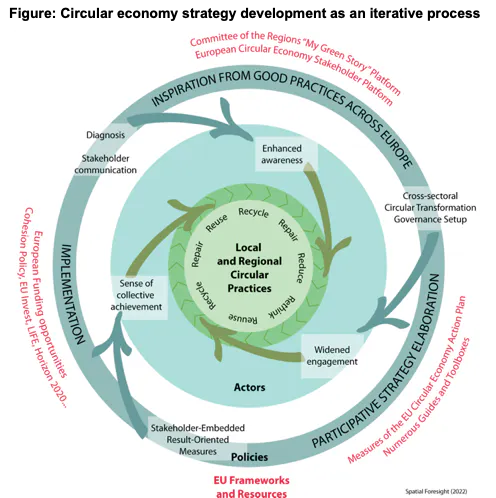EU Green Deal going local & regional: Sustainable consumption, production, circular economy
November 2022
The EU transition towards a circular economy is one of the key elements of the EU plan for achieving sustainable development, i.e. European Green Deal. Although the European Green Deal’s focus areas do not explicitly deal with the circular economy, it is addressed indirectly through several actions (e.g. agriculture, climate and industry).
According to the definition of the European Parliament (S'ouvre dans une nouvelle fenêtre), a circular economy is “a model of production and consumption, which involves sharing, leasing, repairing, refurbishing and recycling existing materials and products as long as possible” with the goal to extend the life cycle of products. The European Commission adopted a new Circular Economy Action Plan in March 2020. The aim of this action plan is to make products fit for a climate-neutral, resource-efficient and circular economy.
To support transition to circular economy and sustainable consumption and production across the EU, the European Committee of the Regions has recently published a handbook for local and regional authorities on how to implement the European Green Deal. As moving towards circularity and sustainable consumption and production is one of the important topics of the European Green Deal, ‘Green Deal Going Local’ Handbook (S'ouvre dans une nouvelle fenêtre) explains four key elements that could be taken into account when progressing towards circular economy and sustainable consumption and production:
Diagnosis. This primary assessment of resources and capabilities can help in addressing development issues, and possibilities for strengthening sustainable production, consumption and circular economy. This diagnosis part also involves communication with stakeholders. The city of Umeå in Sweden implemented the 3Ps (people, policies and places) OECD framework when developing a circular economy strategic plan for 2016-2028. The diagnosis phase of developing this strategy involved conducting a survey with the aim to check respondents’ interest to increase their knowledge of the circular economy and to be engaged in circular economy pilot projects.
Planning. Local and regional authorities may act as key actor for the planning of the circular economy and sustainable production and consumption initiatives. A main coordinator could be nominated within the public administration and his/her key task is to lead the process of drafting a circular economy strategy or action plan. Also, the key coordinator could integrate circular economy principles in the functioning of the administration itself.
Engagement. Engagement of the local stakeholders is an important element in implementation of circular economy goals. The mobilisation of stakeholders could involve different types of stakeholders such as local ambassadors, other public sector partners, sectoral representatives, entrepreneurs, business support structures, research and academia, investors and NGOs. Moreover, local and regional authorities can initiate circular economy initiatives through public procurement. One of the examples for this is the Danish public procurement body SKI (S'ouvre dans une nouvelle fenêtre) which introduced a procurement agreement for the purchase of environmental furniture range.
Monitoring and follow-up. Monitoring and evaluation are inevitable steps in the process of moving towards a circular economy. These two steps provide a chance for local and regional authorities to self-assess their achievements and to adapt their development approach towards circularity consequently.
Taking all this into consideration, local and regional authorities play a vital role in accelerating the achievement of sustainable production and consumption and a circular economy. The figure below synthesis the key steps and actions that may help them establish the right preconditions for a transition towards sustainable production, consumption and a more circular economy. It shows how the transition can be approached as a self-reinforcing virtuous circle. The red text in the outer circle provides examples of how European funding opportunities may be mobilised in each step of the process.

You can find more details on the topic in the full handbook for local and regional governments on how to implement the European Green Deal here (S'ouvre dans une nouvelle fenêtre).
by Paola Marinović, Erik Gløersen, Arndt Münch and Helene Gorny
https://steadyhq.com/en/spatialforesight/posts/e009426e-feff-4c5c-9774-937e87d5fb1a (S'ouvre dans une nouvelle fenêtre) https://steadyhq.com/en/spatialforesight/posts/16c0888b-cae4-4847-867d-055060c9abd6 (S'ouvre dans une nouvelle fenêtre)

